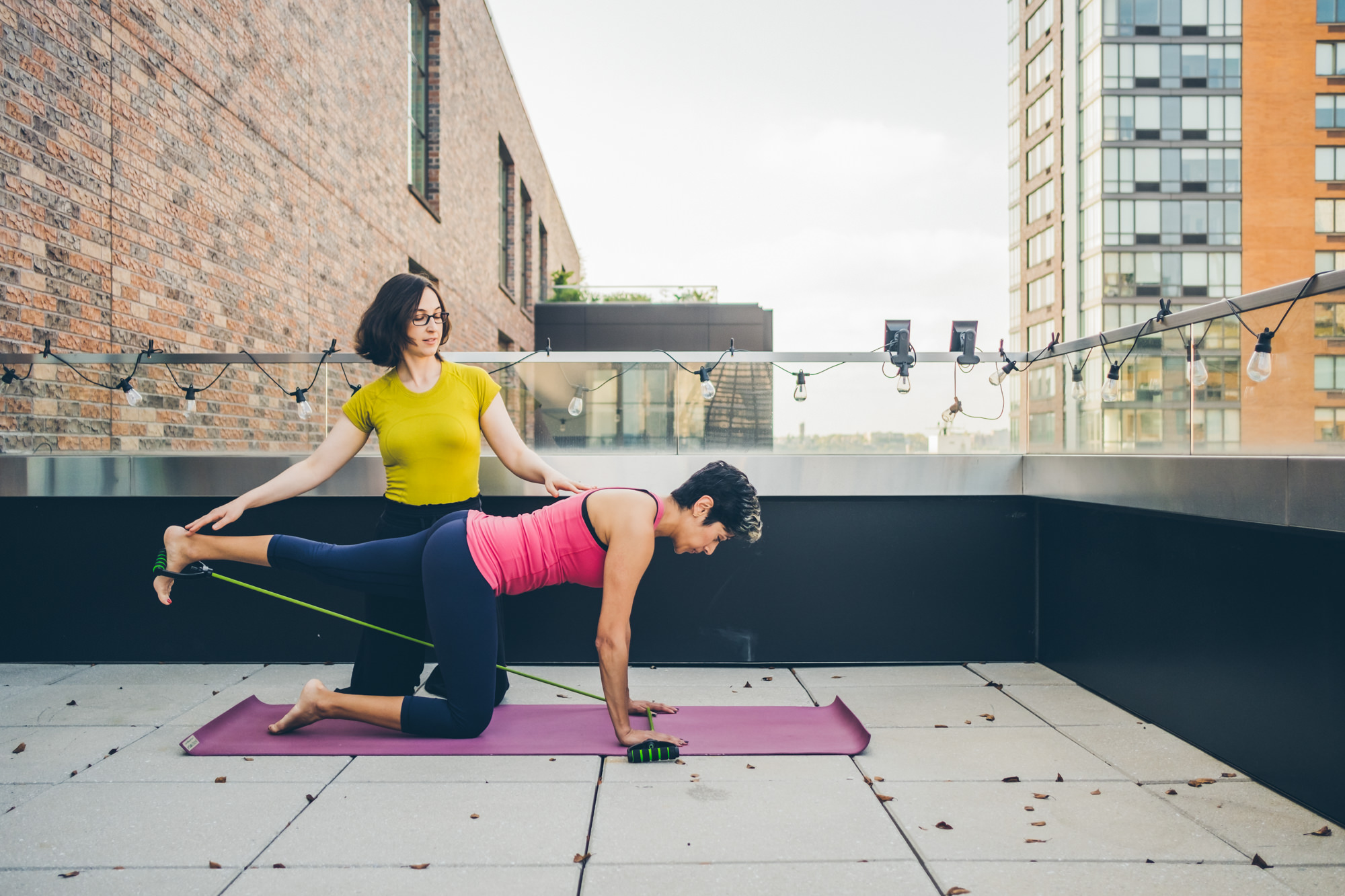Why exercise is a longterm investment

As an independent personal trainer, Pilates, and Yoga teacher my work is largely to help people learn how best to take care of their bodies through physical exercise, and breathing techniques. Over the years of working with people in this capacity I have noticed that many people seem frustrated by the fact that they have to keep up so much regular care and maintenance. They are annoyed when their body seemingly “fails” them by not always being ache free and perfectly functional. I often hear things such as, “I went to physical therapy, and it got better, but now it bothers me again.” The idea seems to be that all physical issues should be “fixable” and then easily ignored. My experience working with people is that it takes regular, committed, and focused attention to our bodies in order to maintain some semblance of functional movement as the decades continue on. In other words it takes an investment of your resources over a long period of time to work towards longevity and a continued rich quality of life.
The next time you feel frustrated that your body doesn’t run perfectly all the time pause for a moment and consider the following two things:
- Our bodies last a long time. Think about the life span of most other animals. While there are exceptions such as the Bowhead Whale which often lives about 200 years, elephants 60 years, and some species of Gorillas living for around 50 years, these examples are not the norm. Humans can live an unusually long time in comparison with other creatures.
- If you owned one house for your whole life, you would expect to have to clean, repair, and do other maintenance on the house. Why would you expect that your body wouldn’t also need regular upkeep and care?

If you want to feel good in your body, thereby being able to enjoy life with regular movement, travel, outdoor adventures, dancing, and just being relatively pain-free as the years go by, you need to think in terms of a committed, regular, sustainable, and enjoyable plan for body care.
A well-rounded program includes being aware of your posture, balance, bone density, muscle strength, heart health, joint health, diet, hydration, and mental well-being. It may seem like a lot to think of, but it is your body! However you treat it now, it will pay you back in the short and long-term.
Fortunately, what is good for one part is usually good for another. For example, strength training is good for your muscles, and your bones. Eating fiber is shown to not only improve digestion, but also help with weight management, and heart health. It is never too late to start as even small improvements can make a big difference to quality of life.
The beautiful thing about taking small steps towards a healthy lifestyle is that like any good investment, it grows on itself. When you do something simple, like going for a walk, you feel better, which enables you to have the energy to make a healthier dinner, which could mean a better nights sleep… and so the cycle continues, building on itself to make you feel and look your best.
Gentle Yoga Post-Feast
Indulging in a delicious meal with family and friends is one of the great joys of the holiday season. Starting with the Thanksgiving feast and going all through the holiday season, it can be a time of enthusiastic eating and drinking. While this is often a pleasure and something many people look forward to all year, sometimes it can be too much for the digestive system and we wind up feeling bloated, and uneasy in the stomach.
Here is a short easy series of yoga poses to help relieve digestive discomfort post-feast. These yoga poses were selected to help massage your internal organs that are associated with the digestive tract. By stimulating the digestive muscles you increase blood flow and movement through your body and help to reduce discomfort and restore energy.
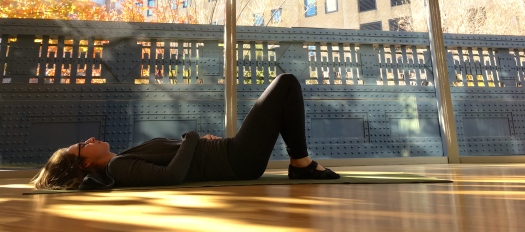
Begin by laying on your back with your knees bent, and feet on the floor. Place your hands onto your abdomen and feel your breath slowly rise and fall. Breathe slowly for a minimum of 1 minute, or as long as it feels comfortable. Slow, calm breathing allows your body to relax and get to work on digesting all that food.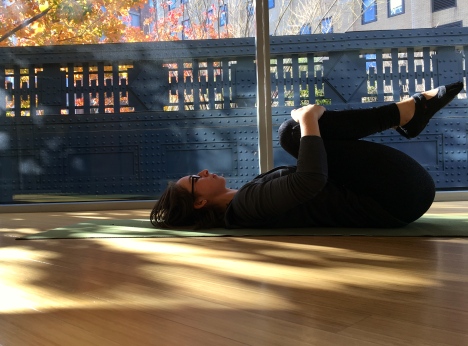
Bring your knees into your chest and give your shins a gentle squeeze. Hold this stretch comfortably for 5-15 slow deep breaths.
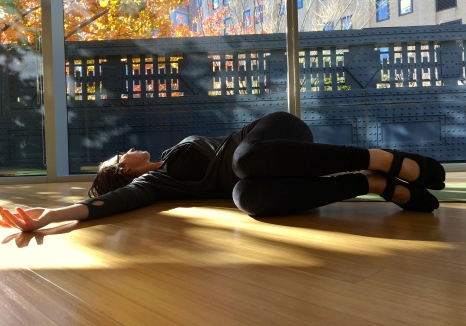
Allow your knees to go over to the right while opening your arms to either side and turning your head to the left. Breath in the twist for 5-15 breaths and then twist the knees over to the left and repeat on the other side. Twisting gently can be beneficial for getting the digestive tract moving. To modify place a pillow or block between your knees to put less of a stretch on your lower back. This is also a good stretch for the neck, shoulders, spine, and hips.
This next series should be taken as a slow moving sequence. Start on your hands and knees. On your inhale, look up towards the ceiling allowing your abdomen to stretch and open. On your exhale, thread an arm underneath your chest and come to lay on your shoulder. Pause in the stretch and breath for 2-4 slow deep breaths. On your next inhale come back to your hands and knees, and look up towards the ceiling. Exhale and thread the other arm underneath. To modify, put a large pillow or yoga block under your head. In addition to aiding digestion, this is also a pleasant stretch for the neck, shoulders, spine and hips.
And last, but not least, take a walk! Walk slowly after a big meal to help get the food moving and ease any post meal discomfort.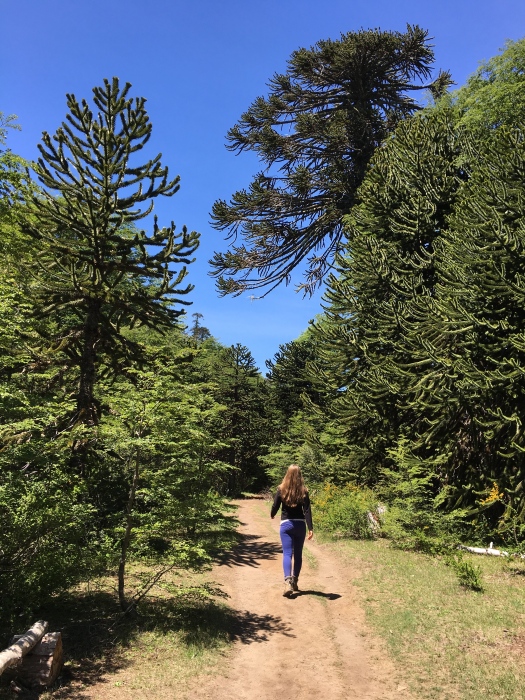 Morgana Tessler is a Certified Orthopedic Personal Trainer, Yoga, Pilates, Meditation and Barre Instructor based in NYC. Morgana offers private and group fitness sessions. For more information visit www.morgana.nyc Facebook, Instagram
Morgana Tessler is a Certified Orthopedic Personal Trainer, Yoga, Pilates, Meditation and Barre Instructor based in NYC. Morgana offers private and group fitness sessions. For more information visit www.morgana.nyc Facebook, Instagram
Outdoor Spring Workout
As the weather turns warmer and the days become longer it is the perfect time to get outside for a workout. No need for the gym or any equipment, this full body workout makes use of your bodyweight and what you’re likely to find in your neighborhood park.
Join Personal Trainer Morgana in this fun outdoor workout!
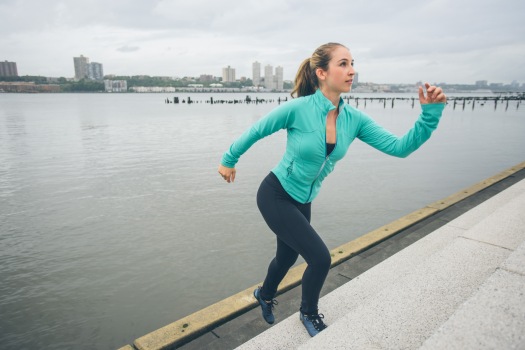
Running up the Stairs: As a warm-up begin by walking briskly up and down a set of stairs. Build the walk up into a fast walk or run.
Squats: A great way to strengthen and tone your glutes and thighs. Starting from a wide parallel stance, bend your knees and send your hips back behind you. Keep your back flat and check that your knees have not gone past your feet. To come up push into your feet and tighten your abs and glutes at the top.
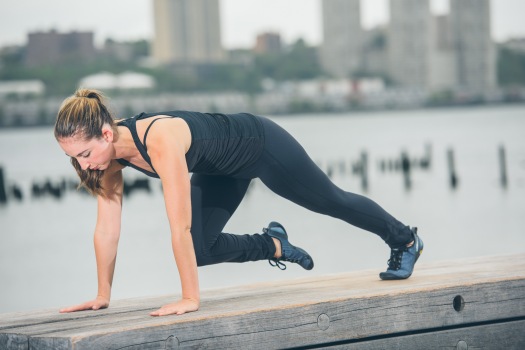
Mountain Climbers: A great exercise for strengthening your core and upper body as well as increasing your heart rate. Starting in a plank position alternate bringing your knees into your chest. To make it more challenging hop your feet in and out one at a time.
Lunge/Balance: Standing with your feet parallel and hip distance apart, bring one knee up and find a balance, hold for a few seconds. Step your lifted leg back into a low lunge. In your lunge lower your back knee so it is parallel with the ground, check that the front knee has not gone past your toes. Pull your abs in and keep your upper body lifted. From the lunge move back up into the balance position.
Tricep Dips: Find a bench and place your palms on the bench pointing towards your body. With either bent or straight knees bend and straighten your elbows squeezing into the back of your arms at the top. Try lifting one leg to make it extra hard!
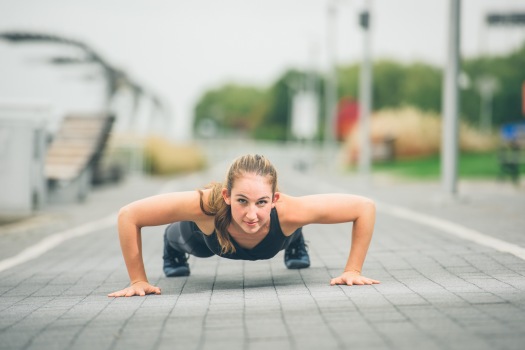
Push-ups: The ultimate core and upper body workout. Starting in a plank with your hands wider than shoulder distance, keep your hips slightly lifted, knees tight, and abs pulled in. Lower towards the ground keeping the correct alignment.
Morgana Tessler is a Certified Orthopedic Personal Trainer, Yoga, Pilates, Meditation and Barre Instructor based in NYC. Morgana offers private and group fitness sessions. For more information visit www.morgana.nyc Facebook, Instagram
